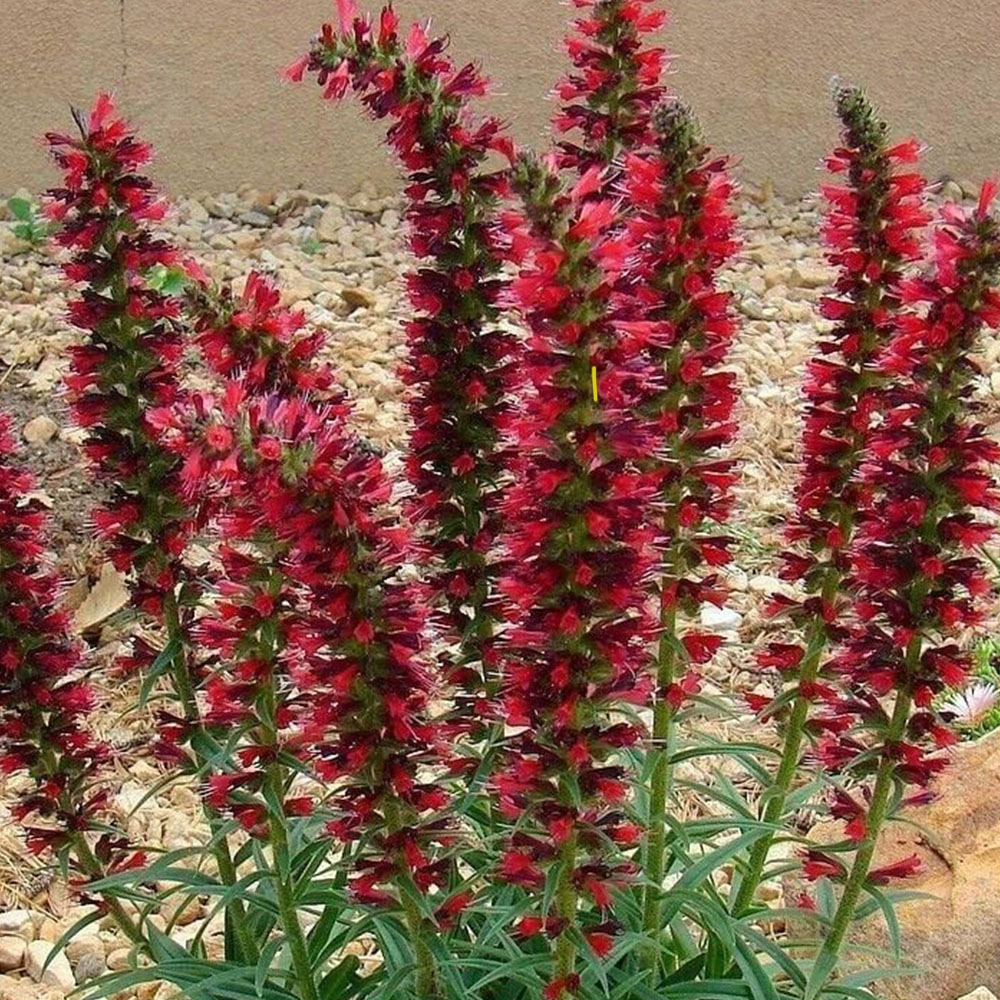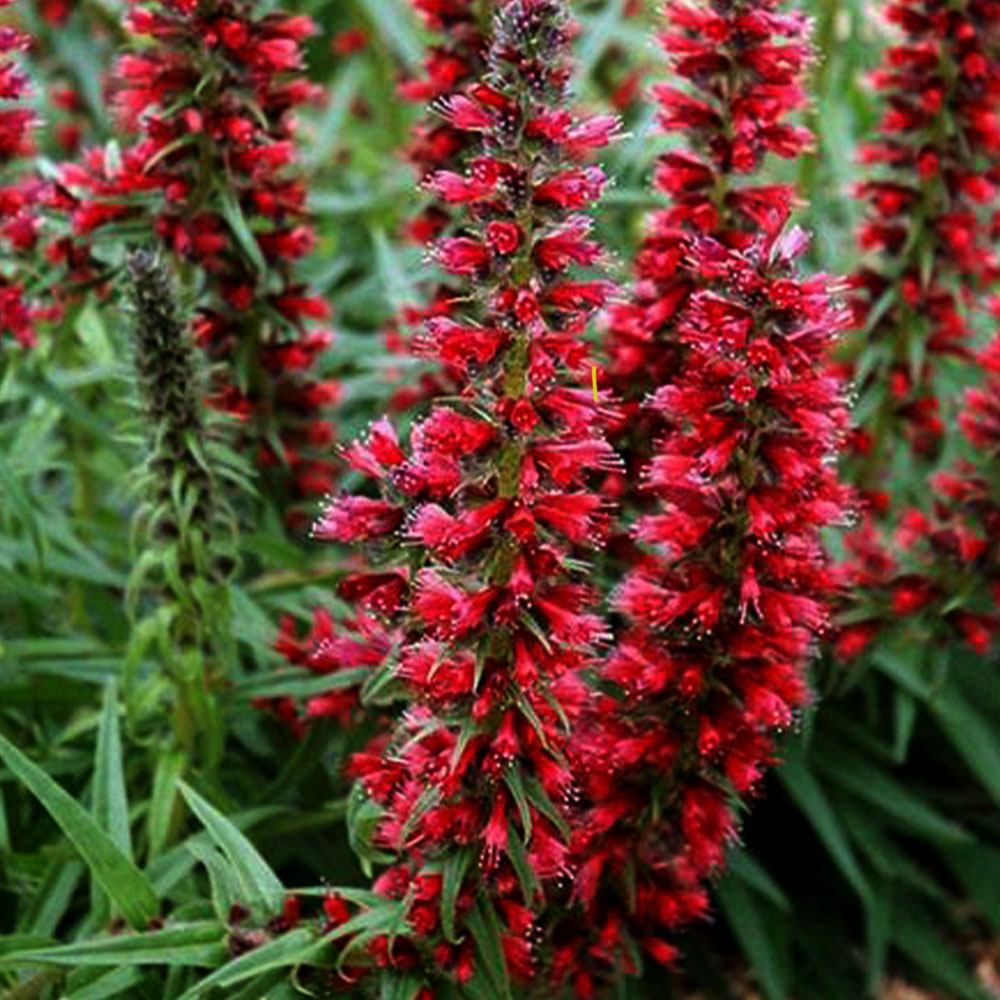-
 € 4,90 × 1×€4.9
€ 4,90 × 1×€4.9
Customer matched zone "Locations not covered by your other zones"
“Echium russicum” has been added to your cart. View cart
Echium russicum
A self-seeding flower with bright red spikes
Rated 0 out of 5
0 customer reviews
€ 4,90
Only 21 item(s) left in stock!
Tags: chaud, couleur, fleurs, graphique, gris, longue floraison, perennial, persistant, plant, potted plant, secheresse, soleil, vivace, vivace en pot, xeriscaping
SKU: pda404
Category: Beauty & Resilience, Bees and Butterflies, Bouquet, Distillations, Fragrant, Frost Hardy, Grey Ladies, Make it Pop, Rewild, Self-Seeding Annual, The Stunners

Echium russicum
€ 4,90
Only 21 item(s) left in stock!
Echium russicum is a magnificent wild viper’s bugloss hailing from Eastern Europe that forms dense burgundy spikes in silver pink tones.
The leaves form a basal rosette and are lance-shaped, greyish-green, hairy, and spiny. A tell tale sign of a highly drought tolerant plant.
The flowers take the form of spectacular long, dense spikes of a general burgundy color but if you peer more closely, you’ll notice that they are composed of a multitude of small flowers in silver pink and wine-red tones, peppered with fine white bristles. As the flowers fade, they take on a slightly light purple hue, creating a kaleidoscope of reds. It really is a sight to behold.
It originates from the hot, dry regions of Eastern Europe, particularly Russia, and Western Asia.
It is renowned for its ability to withstand both scorching high temperatures and prolonged periods of drought, while still producing extraordinary blooms for both pollinators and for our simple delight.
👨🌾 GARDENING TIPS👨🌾:
-
- It is a biennial or perennial plant, depending on the climate and cultivation method.
- Well-suited for embankments, rock gardens, and wild flower beds
- It will self-seed freely so ensure that you cut the flowers (which also look fantastic in bouquets) if you want to minimize your Echium collection
- Do not worry if there are no blooms in the first year! Your Echium is just settling down and making sure that she likes her spot. The plant will form a dense, compact rosette of basal leaves and then will begin blooming from the second year onward.
The Tales:
Honey made by bees that forage on Echium is prized for its beautiful amber color, low crystallization, and mild floral aroma.
In the Middle Ages, followers of the “doctrine of signatures” believed the plant had anti-venom properties due to the resemblance of its stems to snake skin and the fruit’s shape, which was thought to resemble a viper’s head.
Indeed, echium in Greek means ‘viper’ – most probably a reference to the shape of the fruit.
russicum – means hailing from Russia! Ura!
Other Names:
Wild viper’s bugloss
Origin:
Eastern Europe
Similaire
| Weight | 0,2 kg |
|---|---|
| Flower Color | Red |
| Flowering | May, July, August, September |
| Exposure | Full Sun |
| Frost Tolerance | -10°C to -15°C |
| Soil | Dry, Poor, Sandy |
| Size | 0.8m H x 0.4m W |
Reviews
0
Rated 0 out of 5
0 customer reviews
5
0
4
0
3
0
2
0
1
0
Only logged in customers who have purchased this product may leave a review.
You may also like…
Nigella damascena
Delicate blue flowers surrounded by a green mist of lacy feathers for most of the summer.
Delicate blue flowers surrounded by a green mist of lacy feathers for most of the summer.
Rated 0 out of 5
Centaurea montana
A perennial thistle with bright blue flowers atop silver green foliage
A perennial thistle with bright blue flowers atop silver green foliage
Rated 0 out of 5
Rudbeckia hirta ‘Prairie Sun’
A self-seeding annual with bright yellow flowers
A self-seeding annual with bright yellow flowers
Rated 0 out of 5
Stipa tenuifolia
Nassella tenuissima (also known as Stipa tenuissima) is a species of long, blonde, feathery grass.
Nassella tenuissima (also known as Stipa tenuissima) is a species of long, blonde, feathery grass.
Rated 0 out of 5
Echinacea purpurea
A perennial with purple flowers all summer long
A perennial with purple flowers all summer long
Rated 0 out of 5
Related Products
Nepeta x faassenii
Catnip is known for its grey-green, aromatic foliage and masses of lavender blue flowers.
Catnip is known for its grey-green, aromatic foliage and masses of lavender blue flowers.
Rated 0 out of 5
Artemisia ludoviciana ‘Valerie Finnis’
A semi-evergreen, aromatic variation on the theme of Artemisia.
A semi-evergreen, aromatic variation on the theme of Artemisia.
Rated 0 out of 5
Cerastium tomentosum var. columnae
A grey-green spreading ground cover from the mountains.
A grey-green spreading ground cover from the mountains.
Rated 0 out of 5
Stachys byzantina
Silky white-grey leaves and tall striking flowers
Silky white-grey leaves and tall striking flowers
Rated 0 out of 5
Helichrysum orientale
A perennial with soft, ash gray foliage and yellow button flowers
A perennial with soft, ash gray foliage and yellow button flowers
Rated 0 out of 5
Sedum spectabile ‘Septemberglut’
Sedum spectabile ‘Septembergut’ is a species of flowering plant in the stonecrop family – drought tolerant, with vibrant pink flowers and a spectacularly long flowering period.
Sedum spectabile ‘Septembergut’ is a species of flowering plant in the stonecrop family – drought tolerant, with vibrant pink flowers and a spectacularly long flowering period.
Rated 0 out of 5
Helichrysum italicum
An evergrey, fragrant perennial that will bring a distinctly Mediterranean atmosphere.
An evergrey, fragrant perennial that will bring a distinctly Mediterranean atmosphere.
Rated 0 out of 5
Tanacetum densum subsp. amani
A shrublet composed of soft, finely divided silvery gray-white leaves.
A shrublet composed of soft, finely divided silvery gray-white leaves.
Rated 0 out of 5
Mertensia maritima
A deciduous perennial with fleshy, blue-grey-green leaves that naturally thrives on the wind and sea swept coasts
A deciduous perennial with fleshy, blue-grey-green leaves that naturally thrives on the wind and sea swept coasts
Rated 0 out of 5
Salvia sclarea – Clary Sage
A fuzzy perennial that is largely grown for its essential oil.
A fuzzy perennial that is largely grown for its essential oil.
Rated 0 out of 5
Lavandula angustifolia
A highly aromatic, flowering perennial used for cooking in many cultures
A highly aromatic, flowering perennial used for cooking in many cultures
Rated 0 out of 5
Euphorbia myrsinites
Known for its draping form of silver-gray foliage and radiant blooms.
Known for its draping form of silver-gray foliage and radiant blooms.
Rated 0 out of 5
Aegopodium podagraria ‘Variegata’
A popular light, green and white groundcover.
A popular light, green and white groundcover.
Rated 0 out of 5
Artemisia alba subsp camphorata
A highly fragrant, grey-green bush.
A highly fragrant, grey-green bush.
Rated 0 out of 5
Potentilla anserina
A distinctly silvery, silky and lacy perennial.
A distinctly silvery, silky and lacy perennial.
Rated 0 out of 5
Festuca glauca
An ornamental, metallic blue grass
An ornamental, metallic blue grass
Rated 0 out of 5
Jacobaea maritima
A wooly white perennial plant from the Mediterranean region.
A wooly white perennial plant from the Mediterranean region.
Rated 0 out of 5
Salvia officinalis
A fragrant herb used in many cultures for cooking and deserts.
A fragrant herb used in many cultures for cooking and deserts.
Rated 0 out of 5
recent view product
Hieracium maculatum ‘Leopard’
A native perennial with blue-green leaves and a tall yellow flower
A native perennial with blue-green leaves and a tall yellow flower
Rated 0 out of 5
Verbena bonariensis
Long stalks with light, floating purple specks that attract bees
Long stalks with light, floating purple specks that attract bees
Rated 0 out of 5
Tradescantia blossfeldiana ‘Red Hill’
Also known as Tradescantia cerinthoides, this variety has a darker foliage, fuzzy underleaves and a powerful sun and drought resistance.
Also known as Tradescantia cerinthoides, this variety has a darker foliage, fuzzy underleaves and a powerful sun and drought resistance.
Rated 0 out of 5
Euonymus fortunei ‘Emerald Gaiety’
Bush with round green leaves with bright white margins
Bush with round green leaves with bright white margins
Rated 0 out of 5
Liriope muscari ‘Big Blue’
A perennial with evergreen grass-like leaves and tall spikes of lilac flowers in the fall
A perennial with evergreen grass-like leaves and tall spikes of lilac flowers in the fall
Rated 0 out of 5


























































There are no reviews yet.